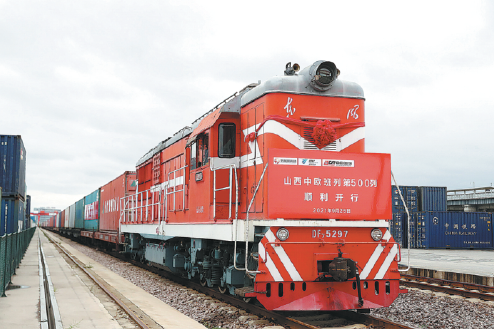On the money: Shanxi among best provinces for economic growth
Updated: 2022-02-25

The 500th train bound for Europe departs from Shanxi on Sept 25. [Photo by Guo Yanjie for China Daily]
Robust trade and demand kept on right track by policies which include industrial upgrades and efficiency drives for State-owned enterprises
Shanxi reported a GDP of 2.26 trillion yuan ($357.68 billion) for 2021. It was the first time that the North China province surpassed 2 trillion yuan in annual GDP.
According to the Shanxi Provincial Statistics Bureau, the year-on-year increase in GDP reached 9.1 percent, ranking third nationwide.
Wei Yongjie, deputy chief of the bureau, said the per capita GDP surpassed 60,000 yuan, or about $10,000 last year. It broke through 50,000 yuan in 2020.
"The remarkable achievement was made in the context of the COVID-19 pandemic, a severe flood and other related natural disasters in October," Wei said.
The official added that the growth was made with improving socioeconomic operations. These include an improvement in economic efficiency; a strong recovery in foreign trade, growing domestic demand and fixed asset investment; an increasing ratio of the service industry in overall economy; and a steady improvement to people's livelihoods.
Shanxi's GDP surpassed the 1 trillion benchmark in 2011 and that figure doubled in only 10 years, Wei said.
Yang Maolin, a researcher and chief of the Shanxi Academy of Social Sciences, said the 2-trillion-yuan GDP figure marked a good start for the 14th Five-Year Plan (2021-25).
"The achievement is a result of Shanxi's recent efforts in improving its economy, including an industrial transformation to reduce its reliance on coal mining and other heavy industries and fostering emerging industries as new growth engines; guiding supply-side reforms through the use of fixed asset investment; and creating a better business environment to attract investment and encourage entrepreneurship," Yang said.
The improving efficiency of State-owned enterprises has contributed to this impressive growth, according to Wei.
The province's SOEs reported a combined business revenue of 1.64 trillion yuan for 2021, growing 13.16 percent year-on-year. Their total profits surged 230.93 percent to 66.1 billion yuan.
Jinneng Holding Group, one of the leading coal-mining and energy companies in Shanxi, is one of the best-performing SOEs in Shanxi.
Reporting a business revenue of 520 billion yuan and a profit of 17.2 billion yuan for 2021, the company ranks 44th among China's top 500 companies and 138th among the world's top 500 companies.
Company executives said its rapid growth in recent years can be attributed to its efforts in improving efficiency by stepping up the construction of smart coal mines.
Jinneng's subsidiary Tashan Coal Mine, for instance, has a special studio dedicated to smart mining.
The studio is used to design and develop technologies, solutions and scenarios for intelligent production, according to Chen Jianlong, chief of the studio.
"Tashan Coal Mine is one of the pioneers of smart mining in China," Chen said. "We are constantly upgrading our equipment and technologies to digitalize our operations."
These upgrades include the use of robots for coal mine shaft patrols and inspection, fully automated coal conveyance, and 5G-connected monitoring, according to Chen.
According to the company, by the end of 2021, Jinneng Holding had upgraded 111 coal mines, or 83 percent of its total, to advanced production sites using the latest technologies and new operational models. Its Tashan and Tongxin coal mines were listed as national pilots of smart mining.
Also driving Shanxi's growth is the foreign trade sector. It surpassed 200 billion yuan last year for the first time, according to Taiyuan Customs.
"Shanxi's foreign trade in cargo reached 223.03 billion yuan last year, growing 48.3 percent from 2020," said Lian Jianyu, a Taiyuan Customs official responsible for statistics. The growth rate is 27 percentage points higher than the national average.
Lian added that provincial exports increased 56.3 percent to 136.6 billion yuan. Meanwhile, imports grew 37.1 percent to 86.43 billion yuan.
The China-Europe freight train service-its Shanxi section opening in 2017-is one of the major drivers boosting Shanxi's international trade, helping to build the province into a hub of opening-up in inland China.
Fully loaded with goods produced in Shanxi, a cargo train departed from the Zhongding Logistics Park in the provincial capital of Taiyuan on Sept 25 bound for Europe. It was the 500th train since the launch of the Sino-European freight train service.
Over the years, the freight trains from Shanxi have reached 27 cities across 12 countries involved in the Belt and Road Initiative.
"We have seen a steady increase of train dispatches over the years," said Zhou Yong, an executive at Shanxi Jinou Logistics, the operator of the train service. "The number has increased from 10 dispatches in 2017 to 50 in 2018, 107 in 2019 and 185 in 2020."
During 2016-19, Shanxi's foreign trade volume increased at an average annual rate of 9.3 percent, according to the Shanxi Provincial Department of Commerce.
In 2020, despite the COVID-19 pandemic, Shanxi's imports and exports of cargo amounted to a record 150 billion yuan, growing 4 percent year-on-year. The increase was 2.1 percentage points higher than the national average.
Guo Yanjie contributed to this story.



